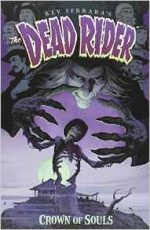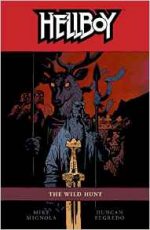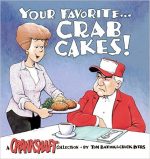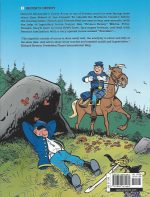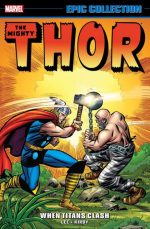
By Stan Lee, Jack Kirby, Chic Stone, Frank Giacoia, Vince Colletta & various (Marvel)
ISBN: 978-0-7851-9446-0
The Mighty Thor was the title in which Jack Kirby’s restless fascination with all things Cosmic was honed and refined through his dazzling graphics and captivating concepts. The King’s career-defining string of power-packed signature pantheons all stemmed from a modest little fantasy/monster title called Journey into Mystery where – in the summer of 1962 – a tried-and-true comicbook concept (feeble mortal transformed into god-like hero) was revived by fledgling Marvel Comics to add a Superman analogue to their growing roster of costumed adventurers.
This bombastic full-colour tome – also available in eFormats – offers more pioneering Asgardian exploits from JiM #110-125 and the cunningly and appropriately retitled Thor #126-130: collectively covering November 1964 to July 1966, and includes a satirically silly snippet from Not Brand Ecch #3 (October 1967) in a blur of innovation and seat-of-the-pants myth-revising and universe-building…
Once upon a time lonely, lamed American doctor Donald Blake took a vacation in Norway only to encounter the vanguard of an alien invasion. Trapped in a cave, Blake found a gnarled old walking stick, which when struck against the ground turned him into the Norse God of Thunder!
Within moments he was defending the weak and smiting the wicked. As months swiftly passed, rapacious extraterrestrials, Commie dictators, costumed crazies and cheap thugs gradually gave way to a vast panoply of fantastic worlds and incredible, mythic menaces.
By issue #110, the magnificent warrior’s ever-expanding world of Asgard was a regular feature and mesmerising milieu for the hero’s earlier adventures, heralding a fresh era of cosmic fantasy to run beside the company’s signature superhero sagas.
Every issue also carried a spectacular back-up series that grew to be a solid fan-favourite. Tales of Asgard – Home of the Mighty Norse Gods gave Kirby space to indulge his fascination with legends and allowed both complete vignettes and longer epics – in every sense of the word.
Initially adapted myths, these little yarns grew into sagas unique to the Marvel universe where Kirby built his own cosmos and mythology, underpinning the company’s entire continuity.
The action opens here with ‘Every Hand Against Him’ (Stan Lee, Kirby & Chic Stone) as Asgardian evildoer Loki and earthly miscreants Cobra and Mr. Hyde kidnap and wound nigh unto death Thor’s merely mortal beloved Jane Foster, even as Odin once again overreacts to Thor’s affections for the human girl.
Following a stunning Kirby & Stone Pin-up Thor Pin-up, and balancing that tension-drenched clash of Good and Evil, is a crafty vignette starring the Young Thor describing ‘The Defeat of Odin!’ with an old and silly plot sweetened by breathtaking battle scenes.
The concluding clash with Hyde and his serpentine ally redefines ‘The Power of the Thunder God’ and features a major role for Balder the Brave, further integrating “historical†and contemporary Asgards in a spellbinding epic of triumph and near-tragedy, after which a Loki Pin-up precedes a short fable co-opting a Greek myth (Antaeus if you’re asking) as ‘The Secret of Sigurd’ by Lee, Kirby and inker Vince Colletta …
Journey into Mystery #112 gave the readers what they had been clamouring for with ‘The Mighty Thor Battles the Incredible Hulk!’: a glorious gift to all those fans who perpetually ask “who’s stronger…?â€
Possibly Kirby & Stone’s finest artistic moment, it details a private duel between the two super-humans that apparently appeared off-camera during a free-for-all between The Avengers, Sub-Mariner and the eponymous Green Goliath. The raw power of that tale is balanced by an eagerly anticipated origin in ‘The Coming of Loki’ (Colletta inks): a retelling of how Odin came to adopt the baby son of Laufey, the Giant King.
In #113 ‘A World Gone Mad!’ by Lee, Kirby & Stone, the Thunderer, after saving the Shining Realm from invasion, once more defies his father Odin to romantically pursue the mortal nurse Jane – a task made rather hazardous by the return of the petrifying villain Grey Gargoyle.
A long-running plot strand – almost interminably so – was the soap-opera tangle caused by Don Blake’s love for his nurse – a passion his alter ego shared. Sadly, the Overlord of Asgard refused to allow his son to love a mortal, which acrimonious triangle provided many attempts to humanise and de-power Thor, already a hero few villains could cope with.
The mythic moment then exposed ‘The Boyhood of Loki!’ (inked by Colletta), a pensive, brooding foretaste of the villain to be.
JiM #114 began a two-part tale introducing a new villain of the sort Kirby excelled at: a vicious thug who suddenly lucked into overwhelming power. ‘The Stronger I Am, The Sooner I Die!’ finds Loki imbuing hardened felon Crusher Creel with the power to duplicate the strength and attributes of anything he touches, but before he is treated to ‘The Vengeance of the Thunder God’ (inked by Frank Giacoia as the pseudonymous Frankie Ray) we’re graced with another Asgardian parable – ‘The Golden Apples’. Issue #115’s back-up mini-myth was ‘A Viper in our Midst!’ with young Loki clandestinely cementing relations with the sinister Storm Giants – sworn enemies of the Gods….
A longer Thor saga began in #116, as Colletta settled in as regular inker for both lead and support feature. ‘The Trial of the Gods’ revealed more aspects of fabled Asgard as Thor and Loki undertake a brutal ritualised Trial by Combat, with the god of mischief cheating at every step, after which ‘Into the Blaze of Battle!’ finds Balder protecting Jane Foster even as her godly paramour travels to war-torn Vietnam seeking proof of his step-brother’s infamy.
These yarns are supplemented by stellar novellas ‘The Challenge!’ and ‘The Sword in the Scabbard!’ in which Asgardian cabin-fever develops into a quest to expose a threat to the mystic Odinsword, the unsheathing of which could destroy the universe…
Journey into Mystery #118’s ‘To Kill a Thunder God!’ ramps up the otherworldly drama as Loki, attempting to cover his tracks, unleashes an ancient Asgardian WMD – the Destroyer. When it damages the mystic hammer of Thor and nearly kills our hero in ‘The Day of the Destroyer!’, the God of Mischief is forced to save his step-brother or bear the brunt of Odin’s anger.
Meanwhile in Tales of Asgard the Quest further unfolds with verity-testing talisman ‘The Crimson Hand!’ and ‘Gather, Warriors!‘ with a band of hand-picked “Argonauts†joining Thor’s flying longship in a bold but misguided attempt to forestall Ragnarok…
With Destroyer defeated and Loki temporarily thwarted, Thor returns to America ‘With My Hammer in Hand…!’ only to clash once more with the awesome Absorbing Man. However, before that bombastic battle there’s not only the next instalment of the Asgardian Argonauts who boldly ‘Set Sail!’ but also the admittedly superb digression of the lead story from Journey into Mystery Annual #1, wherein in undisclosed ages past the God of Thunder fell into the realm of the Greek Gods for landmark heroic hullabaloo ‘When Titans Clash! Thor vs. Hercules!’…
This incredible all-action episode is augmented here by a beautiful double-page pin-up of downtown Asgard – a true example of Kirby magic.
The Thunderer’s attack of the Absorbing Man resumes in ‘The Power! The Passion! The Pride!’ seemingly set to see the end of Thor: a cliffhanger somewhat assuaged by ‘Maelstrom!’ wherein the Argonauts epically encounter an uncanny storm…
In JiM #122’s ‘Where Mortals Fear to Tread!‘ the triumphant Crusher Creel is abducted by Loki to attack Asgard and Odin himself: an astounding clash leading to a cataclysmic conclusion ‘While a Universe Trembles!’
Meanwhile ‘The Grim Specter of Mutiny!’ invoked by seditious Loki is quashed in time for valiant Balder to save the Argonauts from ‘The Jaws of the Dragon!’ in the ever-escalating Ragnarok Quest.
With the contemporary threat to Asgard ended and Creel banished, Thor returns to Earth to defeat the Demon, a witchdoctor empowered by a magical Asgardian Norn Stone left behind after the Thunder God’s Vietnamese venture. Whilst the Storm Lord was away Hercules was dispatched to Earth on a reconnaissance mission for Zeus. ‘The Grandeur and the Glory!’ opened another extended story-arc and action extravaganza, which bounced the Thunderer from bruising battle to brutal defeat to ascendant triumph.
Issue #125 ‘When Meet the Immortals!’ was the last Journey into Mystery: with the following month’s ‘Whom the Gods Would Destroy!’ the comic was re-titled The Mighty Thor and the drama amped up unabated, culminating with ‘The Hammer and the Holocaust!’
In short order Thor crushed the Demon, seemingly lost beloved Jane to Hercules, was deprived of his powers and subsequently thrashed by the Grecian Prince of Power, yet still managed to save Asgard from unscrupulous traitor Seidring the Merciless who had usurped Odin’s mystic might…
Meanwhile in the Tales of Asgard instalments the Questers homed in on the cause of all their woes. ‘Closer Comes the Swarm’ pitted them against the flying trolls of Thryheim, whilst ‘The Queen Commands’ saw Loki captured until Thor answered ‘The Summons!’, promptly returning the Argonauts to Asgard to be shown ‘The Meaning of Ragnarok!’
In all honestly these mini-eddas were, although still magnificent in visual excitement, becoming rather rambling in plot, so the narrative reset was neither unexpected nor unwelcome…
Instead of ending, the grandiose saga actually grew in scope with Thor #128 as ‘The Power of Pluto!’ introduced another major foe. The Greek God of the Underworld had tricked Hercules into replacing him in his dread, dead domain, just as the recuperated Thunder God was looking for a rematch, whilst in Tales of Asgard Kirby pulled out all the creative stops to depict the ‘Aftermath!’ of Ragnarok: for many fans the first indication of what was to come in the King’s landmark Fourth World tales half a decade later…
‘The Verdict of Zeus!’ condemns Hercules to the Underworld unless he can find a proxy to fight for him, whilst at the back of the comic the assembled Asgardians faced ‘The Hordes of Harokin’ as another multi-chaptered classic begins, but for once the cosmic scope of the lead feature eclipses the little odysseys as ‘Thunder in the Netherworld!’ reveals Thor and Hercules carving a swathe of destruction through an unbelievably alien landscape – the beginning of a gradual side-lining of Earthly matters and mere crime-fighting.
Thor and Kirby were increasingly expending their efforts in greater realms than ours…
‘The Fateful Change!’ then reveals how the younger Thunder God trades places with the Genghis Khan-like Harokin… leaving the drama on a tense cliff hanger until the next collected volume…
However there’s one last reading treat in store as Marvel’s superhero spoof title Not Brand Echh #3 provides a barbed and pitiless pastiche of the Asgardian (Jazzgardian, in fact!) life in ‘The Origin of Sore, Son of Shmodin!’ by Lee, Kirby & Giacoia, as well as a glimpse at a 1965 T-Shirt design by Kirby and Dick Ayers, a selection of original art pages from the stories in this volume and a gallery of classic covers modified by painter Dean White…
These transitional Thor tales show the development not only of one of Marvel’s fundamental continuity concepts but more importantly the creative evolution of the greatest imagination in comics. Set your common sense on pause and simply wallow in the glorious imagery and power of these classic adventures for the true secret of what makes graphic narrative a unique experience.
© 1964, 1965, 1966, 1967, 2016 Marvel Characters, Inc. All rights reserved.


